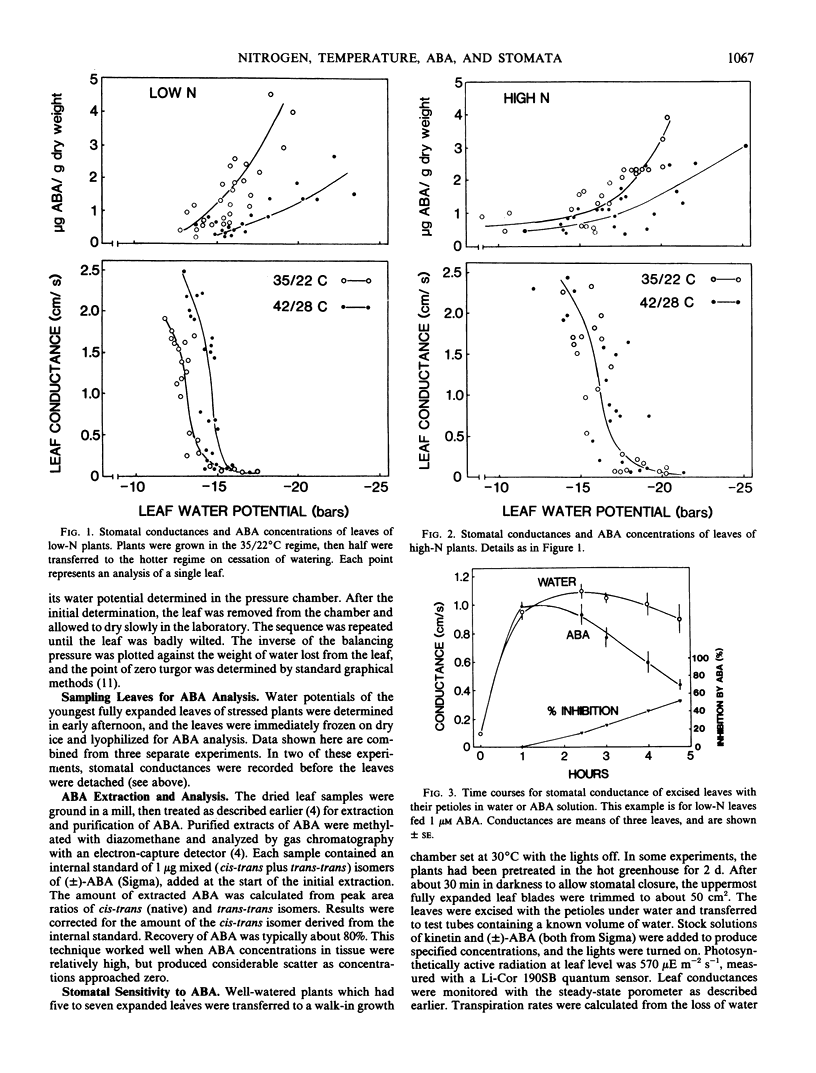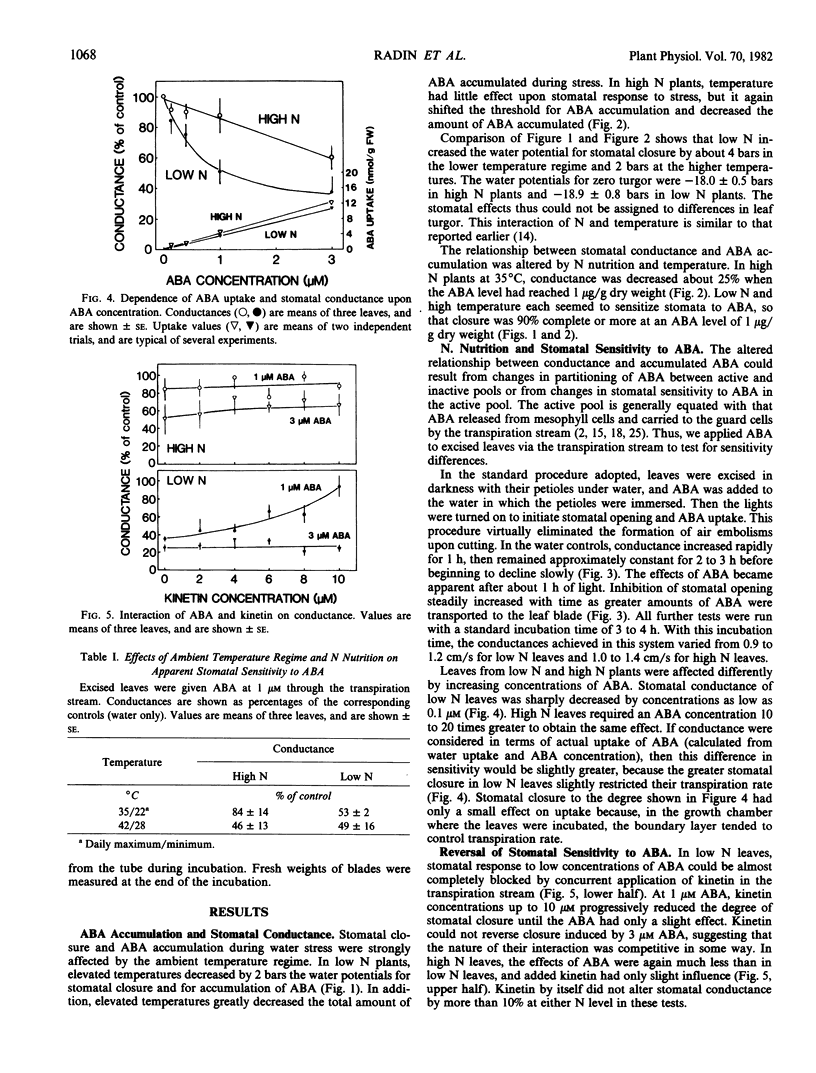Abstract
Suboptimal N nutrition increased the water potential for stomatal closure in water stressed cotton (Gossypium hirsutum L.) leaves. This increased sensitivity to water stress had two components, increased accumulation of abscisic acid (ABA) and increased apparent stomatal sensitivity to ABA. Low N increased the threshold water potentials for stomatal closure and ABA accumulation by about 4 bars and 2 bars, respectively. Low N also greatly increased stomatal response to low concentrations of exogenous ABA applied to excised leaves through the transpiration stream. In low N leaves, kinetin decreased stomatal response to ABA to the level observed with high N leaves. Kinetin by itself had little effect on stomata, nor did it alter stomatal response to ABA in high N leaves. The results suggest a cytokinin-ABA balance which is altered by suboptimal N nutrition to favor stomatal closure during stress.
Ambient temperature and N nutrition interacted to alter stomatal response to water stress. Stress-induced ABA accumulation and apparent stomatal sensitivity to ABA were independently affected. The effects of each treatment, and their interaction, could be explained as the net result of changes in both accumulation and apparent sensitivity. Although the results document environmental control of stomatal response to ABA, either altered partitioning of ABA between active and inactive pools, or altered sensitivity of the guard cells, could account for the data.
Full text
PDF




Selected References
These references are in PubMed. This may not be the complete list of references from this article.
- Ackerson R. C. Stomatal response of cotton to water stress and abscisic Acid as affected by water stress history. Plant Physiol. 1980 Mar;65(3):455–459. doi: 10.1104/pp.65.3.455. [DOI] [PMC free article] [PubMed] [Google Scholar]
- Ackerson R. C. Synthesis and movement of abscisic Acid in water-stressed cotton leaves. Plant Physiol. 1982 Mar;69(3):609–613. doi: 10.1104/pp.69.3.609. [DOI] [PMC free article] [PubMed] [Google Scholar]
- Guinn G. Fruit age and changes in abscisic Acid content, ethylene production, and abscission rate of cotton fruits. Plant Physiol. 1982 Feb;69(2):349–352. doi: 10.1104/pp.69.2.349. [DOI] [PMC free article] [PubMed] [Google Scholar]
- Johnson J. D. Two types of ventilated porometers compared on broadleaf and coniferous species. Plant Physiol. 1981 Aug;68(2):506–508. doi: 10.1104/pp.68.2.506. [DOI] [PMC free article] [PubMed] [Google Scholar]
- Kaiser W. M., Hartung W. Uptake and Release of Abscisic Acid by Isolated Photoautotrophic Mesophyll Cells, Depending on pH Gradients. Plant Physiol. 1981 Jul;68(1):202–206. doi: 10.1104/pp.68.1.202. [DOI] [PMC free article] [PubMed] [Google Scholar]
- Radin J. W., Parker L. L. Water Relations of Cotton Plants under Nitrogen Deficiency: I. Dependence upon Leaf Structure. Plant Physiol. 1979 Sep;64(3):495–498. doi: 10.1104/pp.64.3.495. [DOI] [PMC free article] [PubMed] [Google Scholar]
- Radin J. W., Parker L. L. Water Relations of Cotton Plants under Nitrogen Deficiency: II. Environmental Interactions on Stomata. Plant Physiol. 1979 Sep;64(3):499–501. doi: 10.1104/pp.64.3.499. [DOI] [PMC free article] [PubMed] [Google Scholar]
- Radin J. W. Water Relations of Cotton Plants under Nitrogen Deficiency: III. STOMATAL CONDUCTANCE, PHOTOSYNTHESIS, AND ABSCISIC ACID ACCUMULATION DURING DROUGHT. Plant Physiol. 1981 Jan;67(1):115–119. doi: 10.1104/pp.67.1.115. [DOI] [PMC free article] [PubMed] [Google Scholar]
- Raschke K., Pierce M., Popiela C. C. Abscisic Acid Content and Stomatal Sensitivity to CO(2) in Leaves of Xanthium strumarium L. after Pretreatments in Warm and Cold Growth Chambers. Plant Physiol. 1976 Jan;57(1):115–121. doi: 10.1104/pp.57.1.115. [DOI] [PMC free article] [PubMed] [Google Scholar]
- Raschke K., Zeevaart J. A. Abscisic Acid Content, Transpiration, and Stomatal Conductance As Related to Leaf Age in Plants of Xanthium strumarium L. Plant Physiol. 1976 Aug;58(2):169–174. doi: 10.1104/pp.58.2.169. [DOI] [PMC free article] [PubMed] [Google Scholar]
- Scholander P. F., Hammel H. T., Hemmingsen E. A., Bradstreet E. D. HYDROSTATIC PRESSURE AND OSMOTIC POTENTIAL IN LEAVES OF MANGROVES AND SOME OTHER PLANTS. Proc Natl Acad Sci U S A. 1964 Jul;52(1):119–125. doi: 10.1073/pnas.52.1.119. [DOI] [PMC free article] [PubMed] [Google Scholar]


